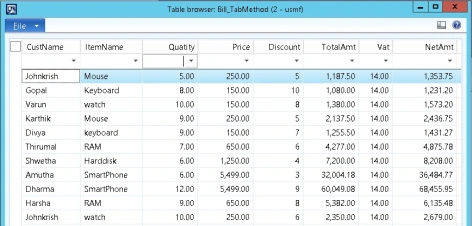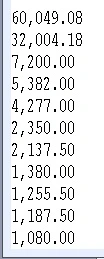| Keyword |
Example |
| asc |
Set the sorting order to ascending. All selects are default fetching data ascending. |
| Syntax: select custTable order by accountNum asc; |
|
| desc |
Set the sorting order to descending. Used in combination with order by or group by. |
| Syntax: select custTable order by name desc; |
| AX Example: See table method CustTable.lastPayment(). |
|
| avg |
Select uses aggregate keyword (avg) using only one call to the database calculating a result based on multiple records |
| Syntax: select avg(amountMST) from custTrans; |
| AX Example: See class method KMKnowledgeCollectorStatisticsExecute.runQuery(). |
|
| count |
Aggregate keyword used to count the number of records fetched. |
| Syntax: select count(recId) from custTrans; |
| AX Example: See class method KMKnowledgeCollectorStatisticsExecute.runQuery(). |
|
| sum |
Aggregate keyword used to sum values of a field fetched. |
| Syntax: select sum(amountMST) from custTrans; |
| AX Example: See class method KMKnowledgeCollectorStatisticsExecute.runQuery(). |
|
| maxof |
Aggregate keyword used to return the highest field value fetched |
| Syntax: select maxOf(amountMST) from custTrans; |
| AX Example: See class method KMKnowledgeCollectorStatisticsExecute.runQuery(). |
|
| minof |
Aggregate keyword used to return the lowest field value fetched. |
| Syntax: select minOf(amountMST) from custTrans; |
| AX Example: See class method KMKnowledgeCollectorStatisticsExecute.runQuery(). |
|
| delete_from |
Will delete multiple records in one call to the database. |
| Syntax: delete_from myTable where myTable.amountMST <=’1000′; |
| AX Example: See class method InventCostCleanUp.updateDelSettlement(). |
|
| exists join |
Exists join is used to fetch records where at least one record in the secondary table matches the join expression.
No records will be fetched from the secondary table using exists join. |
Syntax: while select custTable exists join custTrans
where custTable.accountNum == custTrans.accountNum |
| AX Example: See class method InventAdj_Cancel.cancelInventSettlements(). |
|
| notexists join |
Opposite of exists join. Will fetch records from the primary table, where no records in the secondary table match the join expression. |
Syntax: while select custTable notexists join custTrans
where custTable.accountNum == custTrans.accountNum |
| AX Example: See class method InventConsistencyCheck_Trans.run(). |
|
| outer join |
Outer join will select records from both tables regardless if there are any records in the secondary table matching the join expression. |
| Syntax: while select custTable outer join custTrans |
| AX Example: See class method SysHelpStatistics.doTeams(). |
|
| join |
Join will fetch Records matching the join expressionfrom both tables. (innerjoin) |
Syntax: while select custTable join custTrans
where custTable.accountNum == custTrans.accountNum |
| AX Example: See table method SalesTable.LastConfirm(). |
|
| firstfast |
Instruct to select the first record faster. used in situations where only one record is shown, like in a dialog. |
| Syntax: select firstfast custTable order by accountNum; |
| AX Example: See class method ProjPeriodCreatePeriod.dialog(). |
|
| firstonly |
First record will be selected. Firstonly should always be used when not using while in selects. |
| Syntax: select firstonly custTable where custTable.AccountNum == _custAccount (variable) |
| AX Example: See Table method CustTable.find(). |
|
| forupdate |
Used If records in a select are to be updated |
| Syntax: while select forupdate reqTransBOM where reqTransBOM.ReqPlanId == this.ReqPlanId |
| AX Example: See Table method ReqTrans.deleteExplosionCoverage(). |
|
| from |
Default all fields of a table is selected. From is used to select only the fields specified.
Use it for optimization only, as it makes the code more complex. |
| Syntax: select accountNum, name from custTable; |
|
| group by |
Sort the fetched data group by the fields specified. Only the fields specified in the group by will be fetched. |
| Syntax: while select custTable group by custGroup; |
| AX Example: See class method InventStatisticsUS.calcTotals(). |
|
| index |
Used to set the sorting order of the fetched data. The kernel will convert the keyword index to an order by using the fields from the index.
Index should only be used if the fetched data must be sorted in a specific way, as the database will choose a proper index. |
| Syntax: while select custTable index accountIdx. |
|
| index hint |
Index hint will force the database to use the specified index. |
| Syntax: while select custTable index hint accountIdx. |
| AX Example: See Table method ReqTrans.deleteExplosionCoverage(). |
|
| insert_recordset |
Used to insert multiple records in a table. Insert_recordset is useful when copying data from one table to another as it only requires one call to the database |
Syntax: insert_recordset myTable (myNum,mySum)
select myNum, sum(myValue) from anotherTable group by myNum where myNum <= 100; |
| AX Example: See class method SysLicenseCodeReadFile.handleDomainLicenseChanges(). |
|
| update_recordset |
Used to update multiple records in one database call. Useful to initialize fields in a fast way.
The fields updated are specified after thekeyword setting. |
| Syntax: update_recordset myTable setting field1 = myTable.field1 * 1.10; |
| AX Example: See class method ProdUpdHistoricalCost.postScrap(). |

